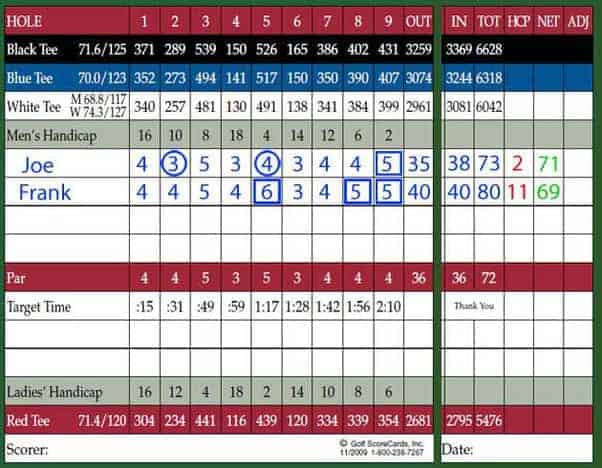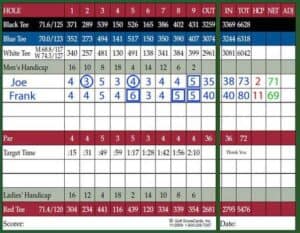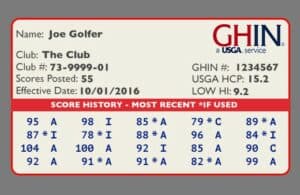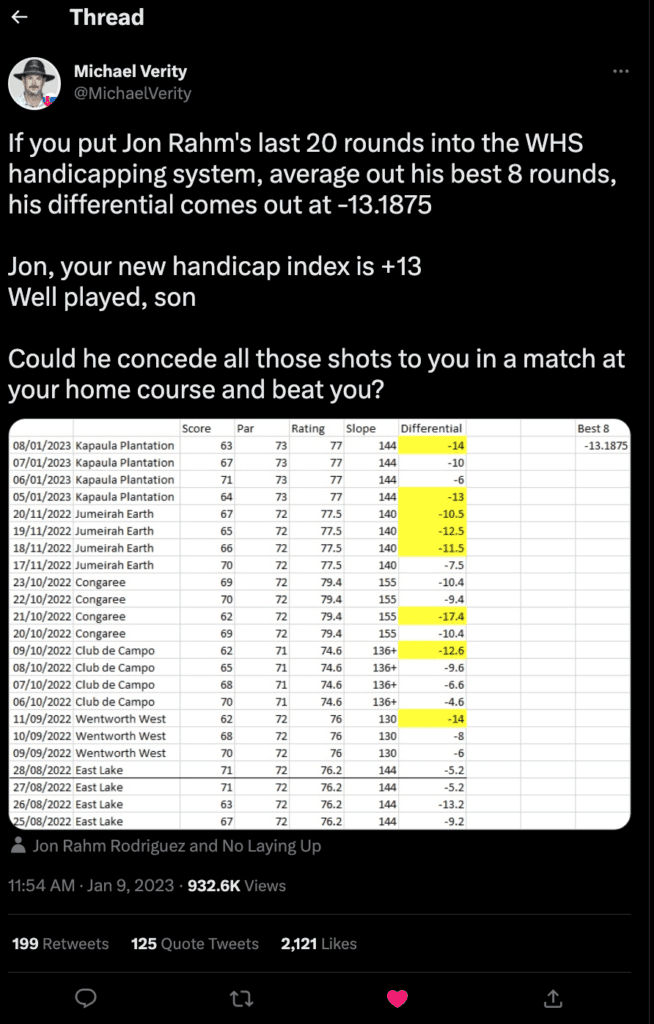- Updated: April 5, 2023
What is a Handicap in Golf?
A Golf Handicap represents any player’s current ability to score for a full round of golf based on their previous round’s scores. The Golf Handicap System gives golfers a way to compete fairly against each other in competition by assigning a Handicap Number that golfers compare against one anothers.
The problem is golf’s handicap system has had a few variations and uses a bunch of different vocabulary and technical jargon that can lead to confusion for new golfers beginning their journey into taking the game more seriously.
Our breakdown below will clear up any uncertainty surrounding what a handicap is, how to formulate your own handicap index, and how to obtain an official handicap to use for competitive play.

Why is Having a Golf Handicap So Important?
Your “golf handicap” equalizes the playing field, no matter the golfer’s skill level.
Very rarely will two random golfers have the exact same playing ability.
For example, if you joined a “Men’s or Women’s League” at your home course or signed up for a competition, new golfers might be less skilled than you, and more experienced golfers may play better than you.
Your golf handicap evens the playing field so everyone can play, compete fairly, and have an equal chance of winning.

Golf Handicap Explained:
Most of the confusion surrounding the handicap system is based on the idea that a golfer’s handicap index is reflective of what they should shoot every round.
Nothing could be further from the truth, and here’s why:
How Does a Golf Handicap Work?
The “World Handicap System” uses any golfer’s most recent 20 complete round scores and takes the average of your eight best scores to determine your “Handicap Index.”
Your “Handicap Index” (more commonly referred to as just a “golfer’s handicap“) is a numerical measure that represents a golfer’s current ability, based on their most recently achieved best scores, relative to the difficulty of the course played (a.k.a Score Differential but we’ll touch on that a bit later).
Put simply, a lower Handicap Index correlates to a more skillful golfer, and a higher Handicap Index correlates to a less skillful golfer.

The individual handicap you earn through “posting scores” represents the number of additional strokes you’re expected to shoot over the “Par Rating” (how many strokes are expected of a “scratch golfer” to complete a round) of a golf course.
For example, the Par Rating of my golf course is 70.3, and I am a 1 Handicap, so I am expected to complete a round of golf in around 71 strokes on a good day.
Score Differential
From the USGA: ” A score of 80 on a difficult course may be a better performance than a 77 on an easier one, and it is the Score Differential calculation that allows this to be captured.
A Score Differential measures the performance of a round in relation to the relative difficulty of the course that was played, measured by the Course Rating™ and Slope Rating®. The result of the daily playing conditions calculation (PCC) is also included in the Score Differential calculation, which may provide an adjustment if course and/or weather conditions significantly impacted scores on that day.”

All of this might sound challenging, but all that’s required of a golfer is posting their 18 hole scores or their hole-by-hole scores (depending on the eligibility of the golf course they play and how advanced of personal stats a player keeps).
A Complete Golf Handicap Calculation Is Complex
We’re incredibly thankful for apps like the USGA’s GHIN that make it so easy for us to get an accurate handicap. By using an app like this to post their scores, golfer’s receive much more accurate and in-depth data about their performance and a free place to hold their scores.
Suppose you want to make your life exponentially harder or are looking to track your golf handicap for free and independently. In that case, you can calculate your golf handicap (differential) using the following formula:

How to Calculate Your Handicap Differential (FORMULA)
Course Handicap = Handicap Index * (Slope Rating/113) + (Course Rating – Par)
*(For Competition Purposes)* Playing Handicap = Course Handicap * (Handicap Allowance) + (Difference in Par)
But it isn’t just that simple (as if that were simple at all…) because you’ll have to start by changing your “gross scores” to “adjusted scores.”
What is an Adjusted Gross Score?
The new World Handicap System implements a few factors called “Handicap Index Safeguards” that keep golfers’ handicaps reflective of their accurate skill level regardless of abnormal playing conditions, abnormally bad scores, or unusually good scores.
These safeguards include:
“PCC” – Playing Conditions Calculation (for bad weather days.)
“Exceptional Score” – A Score Differential 7 strokes better than your handicap index.
“Most Likely Score” – The score a player records for handicap purposes for a hole that is started but was unable to be finished.
“Net Double Bogey” – A score equal to the Par of a hole plus two strokes and adjusted for any handicap strokes applied on that particular hole.
An “adjusted gross score” is a player’s estimated final score adjusted under the World Handicap System procedures we’ve outlined above.
Handicap Index Has More Meanings Than One
A player’s “Handicap Index” isn’t only an average score of your best 8 rounds; it’s an indication to yourself as well as your playing partners of your very current skill level, a way to have a fair game during a casual round with friends, a progress tracker for your game, a way to enter competitions, a way to set more precise goals for yourself per round, and a way to help choose the best sets of tees to play from with a given group or player.

How to Obtain an "Official Handicap Index"
– Become a Member of Your Local Compliant Golf Club
– Pay a Fee to Your Local Complaint Golf Club
– Join An Online Golf Club
The most costly way to obtain an official handicap index is by joining your local WHS complaint golf club as a member. By becoming a member of a compliant golf club (also referred to as Allied Golf Associations), they’ll provide you with a Handicap Index and pay your fee to the United States Golf Association for your “GHIN Number.”
Your “GHIN Number” is like a social security number, so members of competition boards can look up your most recent scores that you’ll be required to post to maintain an accurate handicap index.
If you don’t have the money, time, or feel the need to join your local golf club as a member, you can often pay them a small one-time fee (between 25-50$) to obtain your GHIN Number and have the ability to post scores to have a handicap index calculated for you.
Lastly, suppose you don’t live very close to golf courses but still want a way to set up your handicap. In that case, the USGA has a rule stating as long as you live within “50 miles of the principal location of the golf club,” you can apply to an “online golf club” for an official handicap. This service costs right around 25$ a year and is a Godsend for many rural golfers.
Free and Inexpensive Handicap Calculating Apps
If you don’t want to pay the fee to your local club for an official handicap index through them, there are many free or close to free resources that calculate your golf handicap for you.
Be warned, some of these methods do not result in “official handicaps” that are used for competition, but they will give you a way to track your own handicap index without having to do a ton of complicated math and allow you to track your progress in depth.
Some of these apps also act as course guides, often giving ariel photos of your golf holes and specific yardages to reach certain targets or get over hazards.
These apps include:
The Grint
Score U

How to Use Your Handicap?
Technically, there are many ways to “use your handicap,” but we’ll explain them all very clearly.
Your responsibility as an upstanding golfer is to post your scores to either the GHIN App or your preferred tracking method of choice immediately following every round to keep an accurate and up-to-date handicap index.

Using Your Handicap Index to Compete Fairly
Suppose a 2 handicap golfer and an 11 handicap golfer were playing against each other with no strokes given to the higher handicap index player. In that case, the lower 2 handicap golfer should almost always be the winner.
The higher handicap player wouldn’t have as much fun knowing they are almost always going to lose, and the lower handicap golfer wouldn’t have very much incentive to take the competition seriously or try their hardest to be the victor.
The handicap system allows better golfers to give an appropriate amount of stroke to worse players to even the scoring conditions on a given day for competitive play.
Depending on the golf course’s difficulty, when implementing two players’ individual handicaps into an app, a 2 handicap golfer would likely be giving the 11 handicap 9 strokes to even both golfers’ chances of winning the competition.
Using Handicaps in Match Play
Match Play is a form of play where each golfer plays directly against an opponent, or team, to earn a point for each hole if they beat their opponents.
Paying attention to the gray sections of the scorecard we included in this section, we included two golfers that have the handicap indexes we mentioned in the example earlier.
Joe is a 2 handicap, and Frank is an 11.
In Match Play, Frank would receive one stroke on the 9 most challenging golf holes (labeled 1-18 in most difficult to least difficult on the scorecard).
Since we are only looking at the front 9 scores here, Frank would receive a stroke on holes three (Scorecard Men’s Handicap 8), five, eight, and nine.

Using Handicaps in Stroke Play
Stroke Play is a form of play where a golfer (or golfers) competes against all others in a competition that compares the total score for one or more rounds.
Using the same example as above, Frank being an 11 handicap index means he gets to subtract 11 strokes from his ending total score in the competition.
Joe, being a 2 handicap, only gets to take 2 strokes from his ending total score.
Even though Joe’s “Gross Score” (score before handicap index subtraction) is lower than Frank’s, Frank’s “Net Score” (score after handicap index subtraction) is lower in total.

Using Your Handicap for a "Target Score"
You can determine your “Target Score” (the score you’ll earn if you play to your skill potential, a.k.a your handicap) by adding your Course Handicap + Par of the Tees being played!
Why Did the Handicap System Have to Change?
As of January 2020, the “World Handicap System” was invented to help unify the different handicap systems around the world and eliminate some confusion golfers in other areas have encountered.
Before the creation of the “WHS,” there were SIX different handicap systems around the world, including the AAG, Golf Australia, GolfRSA, The Council of National Golf Unions, the European Golf Association, the USGA Handicap System, and the R&A Handicap System.
Even worse, each group had its own way of calculating your golf handicap (which meant golfers had to learn the rules relating to their particular area), and identical scores in different systems would calculate a differing resulting Handicap Index!
Frequently Asked Questions About a Golf Handicap:
Q: What is the Average Handicap for Men and Women Golfers?
A: According to the Southern California Golf Association: “The average Handicap Index for men is 14.2. The average Handicap Index for women is 27.5. The majority of male players have a handicap between 7 and 17. The majority of female players have a handicap between 20 and 30.”
Q: Do You Receive an Actual Handicap Index Card?
A: While the card isn’t physical and is evolving with every new score you shoot, attached above is a prime example of what a golfer’s USGA Handicap System “Handicap Card” looks like when a player gives their GHIN number to a competition committee or friend to look at.
It shows your most recent scores, with your eight best scores being marked with an asterisk.

Q: What's the Maximum Handicap Index?
A: Beginning in 2020, the maximum handicap index is 54.0 for all golfers.
Q: What Are Some Bonus Benefits of Having an Official Handicap?
A: Having a handicap and app service along with it provides a place to store your scores long term to track trends and makes recording and keeping track of scores easier.
Q: What Number of Scores are Needed to Calculate My Handicap Index Rating?
A: To calculate the most accurate version of your handicap index, the USGA recommends twenty 18 hole scores.
That being said, the USGA also states that golfers can begin to calculate their golf handicap with as little as three 18 hole scores.
Q: What About Scratch and Better Golfers?
A: A “Scratch Golfer” is a player with a Handicap Index of 0. This means when they step onto a golf course, they have the potential of shooting even par or better on a good day.
It’s also possible to have a handicap much better than zero. The elite-level players will have handicaps that begin with a “=” symbol.
This means when they step on the golf course, they actually give strokes back to the course, meaning a “+2” handicap golfer is expected to shoot 70 on a Par 72 golf course.
Q: What HDCP Do Pro Golfers Have?
Professional golfers don’t have an “official handicap index,” as they play golf against other professionals on an “even” skill level field.
Even though professional golfers don’t carry an official handicap, someone calculated Jon Rahm’s predicted handicap through the WHS by using his last 20 competitive rounds played between 08/2022 and 01/2023, and it came out to a whopping +13…

About The Author
Writers of Independent Golf Reviews
Independent Golf Reviews has tested and reviewed 1000+ golf products over the past 10 years. We use our experience and expertise to give golfers an unbiased insight on the market.
Read more…
Share
Receive the best golf discounts available exclusively for our subscribers and be auto entered into our monthly golf giveaways!
Success!⛳️
You are now an official member of IGR. Keep an eye out for the perks.
No spam, ever. 🔒

